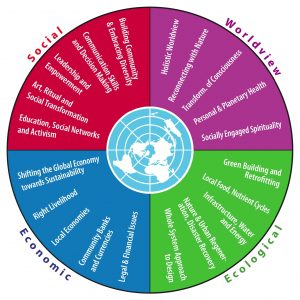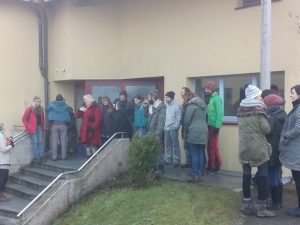What is an eco-village?

While studying at CAT ten years ago, for a masters degree (MSc Advanced Energy and Environmental Studies) I came to the realisation that our future lay in coming together in communities to create places where people can collectively provide shelter, food and social support for one another. Its around this time that I first heard about Findhorn and became interested in eco-villages. I took the ‘eco’ in eco-village to mean ‘ecological’, and had an opinion of what this looked like physically: with low energy homes, built with natural materials and everyone being very conscious of energy and water consumption, recycling everything and of course growing all of their own food. But, I didn’t really know what eco-villages were.
When I finally visited Findhorn last year I was confused initially by the differing opinions amongst people there about what Findhorn actually is: some see it purely as a spiritual community, for some its a college and for others its simply a wonderful place to live. I was focused on green roofs, locally sourced building materials and rainwater collection systems and loved that it has one of the lowest ecological footprints of any community in the world, so I was surprised that there wasn’t more emphasis, within the general community, on the physical ecological aspects of the place. There was some, definitely, but it wasn’t the predominant sense of the place. What I learned, while I was there, was that Findhorn is much more than an ecological community: it is a home and a meeting place, it is a hub for creativity and invention, it is a place of learning and exploration into different ways of living together, sharing, working and resolving problems together. I was so inspired (blown away really) by my experiences there that I created this project: this journey to explore other eco-villages and to see what creativity and inspiration lay in the fabric of their communities.
The Global Eco-village Network (GEN) describes an Eco-village as:
“..an intentional or traditional community using local participatory processes to holistically integrate ecological, economic, social, and cultural dimensions of sustainability in order to regenerate social and natural environments.”
As a means of getting an overview into how eco-villages are created and sustained I decided to attend a month long Eco-village Design Education [EDE] programme in Schloss Glarisegg (a Swiss Eco-village).
GAIA education (partner of the Global Eco-village Network) created the EDE programmes and describes them as follows:
“Ecovillage Design Education programmes, often referred to as ‘EDEs’, provide students of all ages with the knowledge and practical skills on how to design a society which uses energy and materials with greater efficiency, distributes wealth fairly and strives to eliminate the concept of waste.
Students become change agents and sustainability designers, taking active roles in transitioning their existing communities, institutions and neighbourhoods, to more sustainable patterns of production and consumption, as well as leading more joyful, meaningful and healthier lives.”
EDE programmes are based on the four core dimensions of Gaia Education’s Ecovillage Design Curriculum: the Social, Worldview, Ecological and Economic dimensions of sustainability. The Curriculum was developed drawing on the experience and expertise developed in a network of some of the most successful ecovillages and transition settings across the Earth.
So with this description in mind and having met EDE participants at Findhorn I went into the course with some expectations about what we would be learning. Some of what was covered over the course of the month included: Deep democracy and the work of Joanna Macy, permaculture principles, global economics, the economy for the common good, empowered fundraising, gift economy, Global Food issues, possibility management, health and wholeness, spiral dynamics, transparent communication, the politics of food, Dragon Dreaming, decision making, ‘the Work’ by Byron Katie, a ceremony to honour our ancestors, group projects ……….and I could go on. This tells you some of what we covered, it is easy to write about, but it doesn’t give you a sense of how the course actually was. Expressing the experience to you feels fundamentally important to me, but I have really been struggling to find a way to describe it. Obviously with a month long intensive residential course with 55 others, there are going to be many aspects to it, so I will describe a few aspects that felt important to me. (If you want to know in detail exactly what is on the curriculum for an EDE you can follow this link: EDE curriculum PDF )
In relation to my expectation of the course content: I had been nervous that we would cover a lot of factual content that I would have covered in great detail in my MSc in CAT. I thought perhaps I would be getting some updates on facts, figures and design details on the latest research on natural building methods. In fact we covered very very little of the physical hands on design aspects of buildings, and for this I was really grateful. Most of what we covered was experience based learning in groups, from group communication, decision-making, designing, self organisation for preparing all of our own cleaning, food preparation and even some dumpster diving! I was repeatedly surprised at the creativity that went into creating situations in which we applied what we were learning in workshops and discussions. This led, as you can imagine, to stresses and strains at times but ultimately was hugely beneficial in getting an experience of real community living.
The more challenging lessons were in leaning into chaos and finding order, in letting go and trusting in the intelligence of the group; practicing compassion and learning that if I face my fear and get to know a person who really challenges me and remain open to new possibilities I can really learn a new perspective and recognise the other’s place and part in the group.
I learned how to work with younger people: participants were predominantly in their twenty’s or early thirties. This I did find to be a challenge as it felt like an unrealistic demographic for a community learning situation. But through working with younger participants I did find myself feeling combinations of envy at their courage and fearlessness, hope for our future generations because of their passion and daring, and humility at their wisdom and intelligence. I believe that humanity’s future lies in us coming together and finding better ways to live, communicate, co-create and evolve, and this requires huge amounts of passion, creativity and courage – qualities that these young people had in abundance!!
What has been revealed to me from the time spent with the other 55 beings on the EDE and from visiting six eco-communities so far, is that the fundamental thing that underpins eco-communities is the commitment; the intention, to live together. This enriches my understanding of relationship and connection and challenges me to expand and stretch my creativity and compassion to really see and connect with other human beings.
This movement into connection in community is in the opposite direction to where most of the machinations of our commercial society suggests we go. When I look around in cities I see that independence and separation are celebrated and the result is the perpetuation of an economic system that seeks to grow exponentially. The more separated we are the more products we are encouraged to buy, which increases GDP and the demand for more raw materials and the pressure on natural resources and it does NOT bring happiness or the connection that we truly seek. Coming together, to live in community is a move in a very different direction it is one towards sharing resources, seeking out and learning about connection, exploring our inter-dependence; it goes against what is perceived as ‘normal’ and is therefore quite revolutionary! (and exciting!)
In intentional communities people come together in search of a different way to live, to explore how they can share food, work, accommodation, childcare, to create lives of mutual inter-dependence. Every community is different and every future community is going to be different, each with a different flavour and focus. What is being created in eco-villages, regardless of how you define them is truly special, revolutionary and entrenched in hope for a better future for our next seven generations. Our future lies in our ability to live peacefully together, this, we can start now. To learn what it is to truly be in community has everything to do with learning what it is to be truly yourself. This seems to be a contradiction but interestingly it is the glue that binds community together; in a truly functioning healthy community your individuality is celebrated. By becoming the best you can be then you benefit the community and the community benefits you.
So, I have been given a lot to mull over during and after the EDE and I will probably write more about it in future blogs. For now I am humbled by the creators, organisers, presenters, participants and content of this course. I have gained a greater understanding of our human capacity to stretch and include more of one another. I continue to be humbled by the people that I meet, living, teaching and learning in eco villages: by their passion for community and their willingness to open up to new and better ways of living.
Relevant links
Schloss Glarisegg Eco-Community
The Global Eco-village Network
CAT: Centre for alternative technology, Wales
CAT Graduate School of the Environment
Participants at the EDE Glarisegg 2017.
You can support my journey on GoFundMe: Lets create better ways of living


Recent Comments